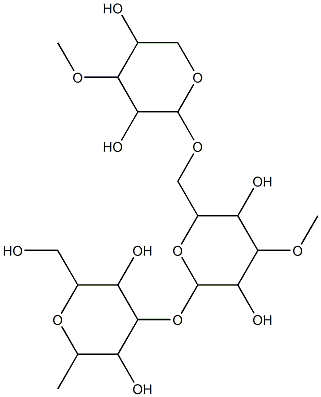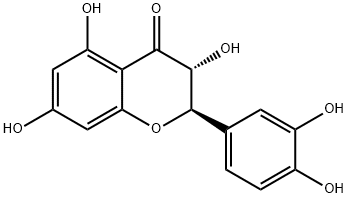ARABINOGALACTAN
Synonym(s):Polyarabinogalactan
- CAS NO.:9036-66-2
- Empirical Formula: C20H36O14
- Molecular Weight: 500.49144
- MDL number: MFCD00062638
- EINECS: 232-910-0
- SAFETY DATA SHEET (SDS)
- Update Date: 2024-12-18 14:07:02

What is ARABINOGALACTAN?
Chemical properties
Dry, light-tan powder. Readily soluble in hot and cold water; both powder and solutions fairly stable. Combustible.
Chemical properties
Polyarabinogalactan possesses a soft, balsamic terpenic odor, reminiscent of fresh conifer resins and cones. It is a turpentine type of a natural oleoresin. It occurs as a physiological secretion in the larch tree, Larix decidua, a conifer.
Occurrence
Reported found in the secretion of the larch tree, Larix deciduas
The Uses of ARABINOGALACTAN
Arabinogalactan is a gum, being the plant extract obtained from larch trees. it is soluble in hot and cold water, the water solutions up to 60% being fluid and above 60% forming a thick paste. it is stable over a wide ph range and is relatively unaffected by electrolytes. its limited uses include dressings and pudding mixes. it is also termed larch gum.
The Uses of ARABINOGALACTAN
immune stimulant, antineoplastic agent
The Uses of ARABINOGALACTAN
galactoarabinan (GA) is a multi-functional ingredient with humectant and exfoliating properties. In aqueous solutions, gA can deposit a clear film, creating or helping to create an occlusive environment, preventing transepidermal water loss and enhancing the functionality of a formulation’s active ingredients. In humid conditions gA acts as a moisture binder, and in dry conditions, it is able to retain moisture, further inhibiting moisture loss from the skin. Additionally, gA can improve particle dispersion and the uniformity of emulsion droplets resulting in a more stable emulsion and potentially more efficacious formulation, particularly in the case of sunscreens. In vitro and in vivo studies indicate possible benefit to the immune system given an ability to enhance Langerhans cell proliferation and cytokine production. gA has been shown to boost AHA exfoliation activity without increasing skin irritation, and it also exhibits its own exfoliant properties independent of AHA presence in a formulation, thereby helping reduce the appearance of fine lines and wrinkles. gA is a polysaccharide found in all plants and is the dominant sugar of the western larch tree.
What are the applications of Application
(+)-Arabinogalactan is an excellent dietary fiber
Definition
A water-soluble polysaccharide extracted from timber of the western larch trees. It is a complex, highly branched polymer of arabinose and galactose.
Preparation
Natural turpentine is obtained from tapping or scraping the wounds on a variety of coniferous trees. Separating the essential oil and solid content of crude turpentine makes pure gum spirits. The crude gum is heated, refined and separated by distillation into gum spirits and rosin.
Biochem/physiol Actions
Dietary fiber that enhances immune system function by stimulating natural killer (NK) cell activity.
Safety Profile
When heated to decomposition it emits acrid smoke and irritating fumes.
Properties of ARABINOGALACTAN
| Melting point: | >200 °C (dec.)(lit.) |
| refractive index | 10 ° (C=1, H2O) |
| FEMA | 3254 | ARABINOGALACTAN |
| storage temp. | 2-8°C |
| solubility | H2O: 50 mg/mL, clear to slightly hazy, faintly yellow |
| form | lyophilized powder |
| color | White to Pale Beige |
| Odor | at 100.00 %. very mild balsam pine resin |
| CAS DataBase Reference | 9036-66-2 |
| EPA Substance Registry System | D-Galacto-L-arabinan (9036-66-2) |
Safety information for ARABINOGALACTAN
Computed Descriptors for ARABINOGALACTAN
New Products
(S)-3-Aminobutanenitrile hydrochloride 4-Methylphenylacetic acid N-Boc-D-alaninol N-BOC-D/L-ALANINOL Tert-butyl bis(2-chloroethyl)carbamate 3-Morpholino-1-(4-nitrophenyl)-5,6-dihydropyridin- 2(1H)-one Furan-2,5-Dicarboxylic Acid Tropic acid 1-Bromo-3,5-Di-Tert-Butylbenzene S-2-CHLORO PROPIONIC ACID ETHYL ISOCYANOACETATE 2-Bromo-1,3-Bis(Dimethylamino)Trimethinium Hexafluorophosphate 4-IODO BENZOIC ACID 3-NITRO-2-METHYL ANILINE 1-(2,4-DICHLOROPHENYL) ETHANAMINE (2-Hydroxyphenyl)acetonitrile 4-Bromopyrazole 2-(Cyanocyclohexyl)acetic acid 4-methoxy-3,5-dinitropyridine 1-(4-(aminomethyl)benzyl)urea hydrochloride 2-aminopropyl benzoate hydrochloride diethyl 2-(2-((tertbutoxycarbonyl)amino) ethyl)malonate tert-butyl 4- (ureidomethyl)benzylcarbamate Ethyl-2-chloro((4-methoxyphenyl)hydrazono)acetateRelated products of tetrahydrofuran








You may like
-
 (+)-Arabinogalactan from Larch Wood CAS 9036-66-2View Details
(+)-Arabinogalactan from Larch Wood CAS 9036-66-2View Details
9036-66-2 -
 (+)-Arabinogalactan CAS 9036-66-2View Details
(+)-Arabinogalactan CAS 9036-66-2View Details
9036-66-2 -
 1975-50-4 98%View Details
1975-50-4 98%View Details
1975-50-4 -
 2-HYDROXY BENZYL ALCOHOL 98%View Details
2-HYDROXY BENZYL ALCOHOL 98%View Details
90-01-7 -
 2-Chloro-1,3-Bis(Dimethylamino)Trimethinium Hexafluorophosphate 221615-75-4 98%View Details
2-Chloro-1,3-Bis(Dimethylamino)Trimethinium Hexafluorophosphate 221615-75-4 98%View Details
221615-75-4 -
 61397-56-6 CIS BROMO BENZOATE 98%View Details
61397-56-6 CIS BROMO BENZOATE 98%View Details
61397-56-6 -
 14714-50-2 (2-Hydroxyphenyl)acetonitrile 98+View Details
14714-50-2 (2-Hydroxyphenyl)acetonitrile 98+View Details
14714-50-2 -
 118753-70-1 98+View Details
118753-70-1 98+View Details
118753-70-1